Module 5: Resident and Family Engagement: Facilitator Notes
AHRQ Safety Program for Long-Term Care: HAIs/CAUTI
Slide 1: Module 5: Resident and Family Engagement

Say:
The Resident and Family Engagement module focuses on the roles and responsibilities of the resident and family as a member of the facility safety team. Engaging the resident and family as partners will help assure they can be active participants in their care and in the decision-making process and understand how the facility is using resources to reduce harm and improve safety.
Slide 2: Objectives

Say:
In this module, we will—
- Define resident- and family-centered care.
- Describe the key concepts of resident- and family-centered care in long-term care (LTC) facilities.
- Explain the importance of engaging residents and family members.
- Describe different methods to engage residents and family members in safety initiatives, especially in the area of reducing infections due to urinary catheters.
- Discuss the roles of resident and family advisors and LTC ombudsman programs in nursing homes' safety teams.
Slide 3: Resident- and Family-Centered Care

Say:
Let's discuss Resident and Family-Centered Care.
Slide 4: What Is Resident- and Family-Centered Care?1,2

Say:
The Advancing Excellence campaign describes Resident- and Family-Centered care as follows; "Person-centered care promotes choice, purpose, and meaning in daily life for residents in a long-term care facility. Person-centered care means that nursing home residents are supported in achieving the level of physical, mental, and psychosocial well-being that is individually practicable. This goal honors the importance of keeping the person at the center of the care planning and decision-making process. Care plans are living documents that are revised to reflect a person's changing needs. In person-centered care, staff places a premium on active listening and observing, so staff can adapt to each resident's changing needs regardless of cognitive abilities."
The person in long-term care facilities is the resident and their family. Family is defined by the resident. Residents, whenever possible, determine the extent to which family are actively engaged in their care decisions.
In person-centered care, resident preferences or past patterns form the basis for decisions around a resident's routine. The core concepts of person-centered care as defined by the Institute for Patient- and Family-Centered Care include: dignity and respect, information sharing, participation, and collaboration.
Dignity and respect
Health care providers listen to and honor resident perspectives and choices, resident and family makeup, knowledge, values, beliefs, and religious and cultural background. All these variables are incorporated into care planning and delivery.
Information sharing
Providers share complete and unbiased information with residents and families in ways that are easily understood and address concerns or questions. Residents and families receive timely, complete and accurate information to participate in care and decision making.
Participation
Residents and families are encouraged to participate in care and decision making at the level they choose.
Collaboration
Residents, families, providers, and health care leaders collaborate in policy and program development, execution and evaluation, as well as in facility design, professional education, and care delivery.
1. Bowers N, Nolet K, Roberts, E, et al. Implementing Change in Long-Term Care: A Practical Guide to Transformation. University of Wisconsin–Madison, School of Nursing; 2007. Accessed September 22, 2014.
2. Institute for Patient and Family Centered Care. Bethesda, MD; December 2010. Accessed September 22, 2014.
Slide 5: What Does Person-Centered Care Look Like?3

Say:
Specific actions that demonstrate person-centered care can be described to help nursing homes improve the quality of care and life of residents. Eliminating the assembly-line approach to care and embracing a philosophy of residents as individuals are key characteristics of a resident-centered facility. Facilities should strive to accommodate resident choices and preferences as one way to support the resident's ability to achieve the best and safest quality of life possible. The key to person-centered care is considering that no decision about the resident should be made without asking, "Have the resident and the family participated in this decision?" If the answer to this question is no, then the next step should be to find ways to include the resident and family in their own care decisions.
Examples of resident choices that help demonstrate person-centered care include:
- Choosing mealtimes;
- Expanding activity choices;
- Choosing bathing preferences;
- Supporting residents occasionally refusing medications or avoiding dietary restrictions;
- Encouraging families to bring familiar items from home to decorate the resident's space; and
- Inviting residents and families to participate in care planning meetings and in safety and quality improvement education and discussions.
It is also important for facilities to educate and empower staff so they can effectively engage residents and families as partners in safety. Efforts to collaborate with resident advisers, advocates, and ombudsmen are other ways facilities can demonstrate a commitment to resident engagement.
3. Love K. Person-Centered Care in Assisted Living: An Informational Guide. Center for Excellence in Assisted Living; June 2010. Accessed September 22, 2014.
Slide 6: Comparing Traditional Care to Person-Centered Care1

Say:
Person-centered care is different from the traditional care model. Care of residents in long-term care settings was originally designed around a medical model. This traditional model is similar to care delivery in a hospital, where care is driven by diagnosis, care tasks, and the individuals who perform the tasks. In the traditional model, management staff frequently make the decisions, with minimal input from frontline providers and without much personalization based on the individual's needs. Some long-term care facilities are using a model that demonstrates person-centered care. In this style of care, the resident and family are actively engaged in their own care. Residents and family are encouraged to be as engaged as the resident's condition allows them to be. The culture at a person-centered facility promotes the philosophy that each person has the opportunity to participate knowledgably and effectively in their care. This slide provides specific examples to help staff understand the differences between the two models of care. Many nursing homes deliver care that reflects characteristics of both styles.
1. Bowers N, Nolet K, Roberts, E, et al. Implementing Change in Long-Term Care: A Practical Guide to Transformation. University of Wisconsin–Madison, School of Nursing; 2007. Accessed September 22, 2014.
Slide 7: Benefits For Residents and Families1

Say:
A person-centered approach provides many benefits for residents and families. The benefits for residents and families include—
- Having personal autonomy and the ability to direct care.
- Being offered choices that foster engagement and improve quality of life.
- Living in an environment that promotes trust and respect.
- Collaborating with staff who are attuned to resident preferences and needs and who will respond appropriately to the resident's preferences.
- The opportunity to achieve the best quality of life possible.
1. Bowers N, Nolet K, Roberts, E, et al. Implementing Change in Long-Term Care: A Practical Guide to Transformation. University of Wisconsin–Madison, School of Nursing; 2007. Accessed September 22, 2014.
Slide 8: Benefits for Staff1

Say:
Person-centered care can also have a positive effect on the staff. Staff working in person-centered facilities state they are able to establish more meaningful relationships with residents and their families. Staff have a greater sense of satisfaction when they are encouraged to understand resident preferences and anticipate and respond in a timely manner to resident and family needs. Staff experience increased efficiency when a facility lets them dedicate time to issues that are important to residents and families. In a resident- and family-centered culture, staff recognize that they are an essential part of the organization and that their work is highly valued.
1. Bowers N, Nolet K, Roberts, E, et al. Implementing Change in Long-Term Care: A Practical Guide to Transformation. University of Wisconsin–Madison, School of Nursing; 2007. Accessed September 22, 2014.
Slide 9: Benefits for the Long-Term Care Facility1

Say:
Long-term care facilities that support resident- and family-centered care report a number of benefits, including—
- Improved quality outcomes due to staff's ability to quickly identify and respond to residents' needs.
- Increased referrals as a result of positive recommendations.
- Decreased staff turnover and increased staff satisfaction.
1. Bowers N, Nolet K, Roberts, E, et al. Implementing Change in Long-Term Care: A Practical Guide to Transformation. University of Wisconsin–Madison, School of Nursing; 2007. Accessed September 22, 2014.
Slide 10: Residents' Preference Satisfaction Interviews4

Say:
Many tools have been developed to help leaders and staff assess how well the facility demonstrates the principles and practices of person-centered care, especially as it relates to understanding resident preferences. These surveys provide useful information that can be used to improve performance in resident- and family-centered care.
4. Advancing Excellence in America's Nursing Homes. Person-Centered Care. Advancing Excellence in America's Nursing Homes. Accessed November 11, 2014.
Slide 11: Resident and Family Engagement

Say:
The next few slides will focus on defining resident and family engagement and providing specific examples of how to engage and partner with residents and family members.
Slide 12: What Is Resident and Family Engagement?5
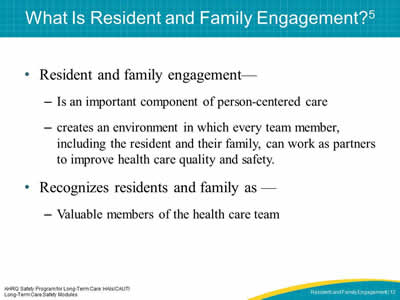
Say:
Resident and family engagement is an important component of person-centered care. It involves the entire team working together to create an environment in which every team member, including the resident and their family, can work as partners to improve health care quality and safety. Residents and family members are valuable members of the health care team who offer a unique perspective on the care provided in a facility. By engaging residents and family members as partners, a facility is able to leverage the skills and knowledge of all team members.
5. Frampton S, Gil H, Guastello S, et al. Long-Term Care Improvement Guide, Planetree, Inc: Derby, CT; 2010. Accessed September 22, 2014.
Slide 13: Importance of Resident and Family Engagement1
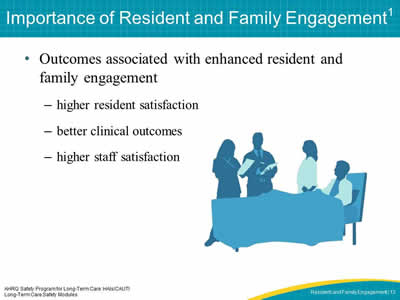
Say:
Resident and family engagement supports a variety of improvements, including—
- Enhanced resident and family satisfaction.
- Improved clinical outcomes.
- Improved staff satisfaction.
These improvements occur as a result of engaging the unique perspectives of residents and families in all decision making.
1. Bowers N, Nolet K, Roberts, E, et al. Implementing Change in Long-Term Care: A Practical Guide to Transformation. University of Wisconsin–Madison, School of Nursing; 2007. Accessed September 22, 2014.
Slide 14: How To Engage Residents and Families5
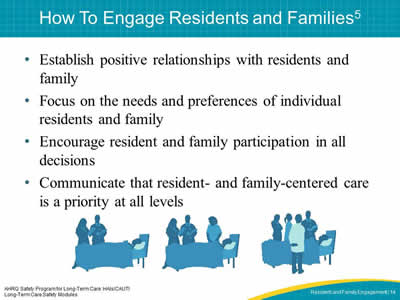
Say:
Staff can create a culture of resident and family-centered care in a variety of ways, including—
- Establishing positive relationships with residents and family,
- Focusing on the needs and preferences of individual residents and family,
- Encouraging resident and family participation in all decisions, and
- Communicating that resident- and family-centered care is a priority at all levels.
A resident- and family-centered care culture requires the support from all staff and the demonstration of the principles and practices throughout the facility.
5. Frampton S, Gil H, Guastello S, et al. Long-Term Care Improvement Guide, Planetree, Inc: Derby, CT; 2010. Accessed September 22, 2014.
Slide 15: Get to Know Your Health Care Team Tool
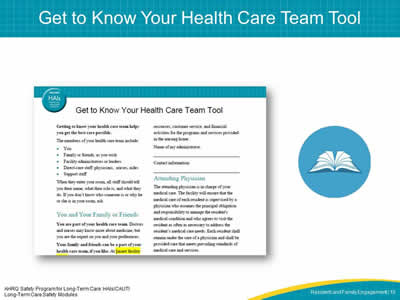
Say:
Establishing trust and a relationship is the first step in engaging with residents and their families. When meeting a resident and family, introduce yourself by name and role. Let them know how you are involved in the resident's plan of care. Ask how the resident and family member would prefer to be addressed, and allow time for the resident and family to ask questions. AHRQ developed a tool to help residents and family members get to know the health care team. Consider sharing this with residents and family members so they feel more comfortable with all team members.
Slide 16: Establishing a Relationship

Say:
Family members have a strong investment in the care and health of their loved one. It's important to listen to their concerns and work with them to develop an individualized plan of care. Watch this video to see a demonstration of staff listening to the concerns of a family member.
PLAY VIDEO:
Video 1.1: Staff Communication
Ask:
What actions did the nurse and certified nurse assistant, or CNA, take in the video to engage the resident's family? What can you and other members of the team do to improve family engagement?
Slide 17: Understanding Resident Preferences1,5
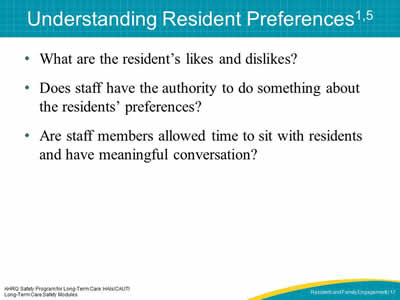
Ask:
Understanding resident preferences is also an important part of establishing relationships with residents and family members. Is frontline staff supported in discovering the likes and dislikes of residents? Do staff have the authority to do something about residents' preferences? Are staff members allowed time to sit with residents and have a meaningful conversation or do an activity together, such as eating lunch or joining them in an activity? What are some ways you have tried to understand resident and family needs and preferences in your facility?
1. Bowers N, Nolet K, Roberts, E, et al. Implementing Change in Long-Term Care: A Practical Guide to Transformation. University of Wisconsin–Madison, School of Nursing; 2007. Accessed September 22, 2014.
5. Frampton S, Gil H, Guastello S, et al. Long-Term Care Improvement Guide, Planetree, Inc: Derby, CT; 2010. Accessed September 22, 2014.
Slide 18: Encourage Participation in Care Planning
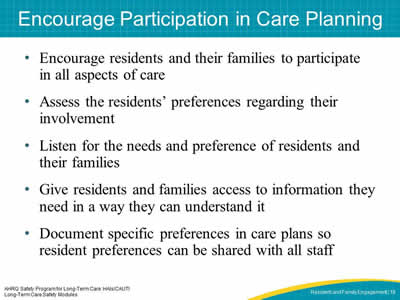
Say:
Residents and family members should be encouraged to participate in the planning and development of care plans, based on the needs, preferences, and abilities of each resident. Residents and families should be given access to relevant health care information in ways that the resident and family can understand the information. Staff should be encouraged to listen to, incorporate, and document resident and family preferences in the resident's plan of care.
Slide 19: Communication and Engaging the Family

Say:
Watch this video to see a demonstration of staff addressing family concerns and including these concerns in the residents' care plan.
PLAY VIDEO:
Video 1.2 Communication and Engaging the Family
Ask:
What actions did the nurse and CNA take to engage the resident's family and address their concerns? What did the staff do to include the resident and family concerns in the resident's plan of care. What are ways you and the rest of the staff in your facility can include preferences in the resident's care plan?
Slide 20: Listening to the Resident and Family
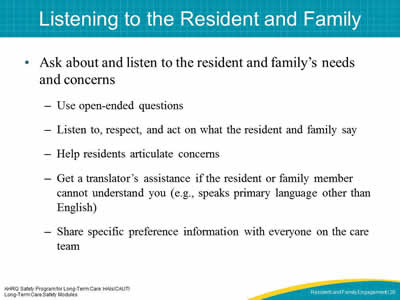
Say:
Clear communication is vital when enhancing resident-and family-centered care. Effective communication begins with listening to the resident and family. Listening to the resident and family can be demonstrated by:
- Using open-ended questions.
- Acting on what the resident and family say.
- Helping residents articulate concerns.
- Getting a translator if needed to support the communication.
- Sharing resident preferences with everyone on the care team.
Slide 21: Explaining Care Plans
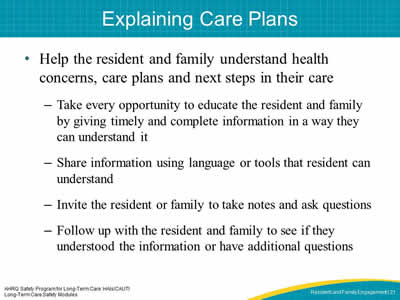
Say:
One of the most important and challenging parts of engaging residents and family members is communication about health concerns, care plans and next steps in their care. These can be difficult conversations but it is important to take every opportunity to engage the resident and family members by providing timely, accurate information, ensuring that the resident and family member understand the language you are using, and allowing plenty of time to ask questions.
Ask:
How can you do a better job communicating with residents and families?
Slide 22: Explaining Care Plans
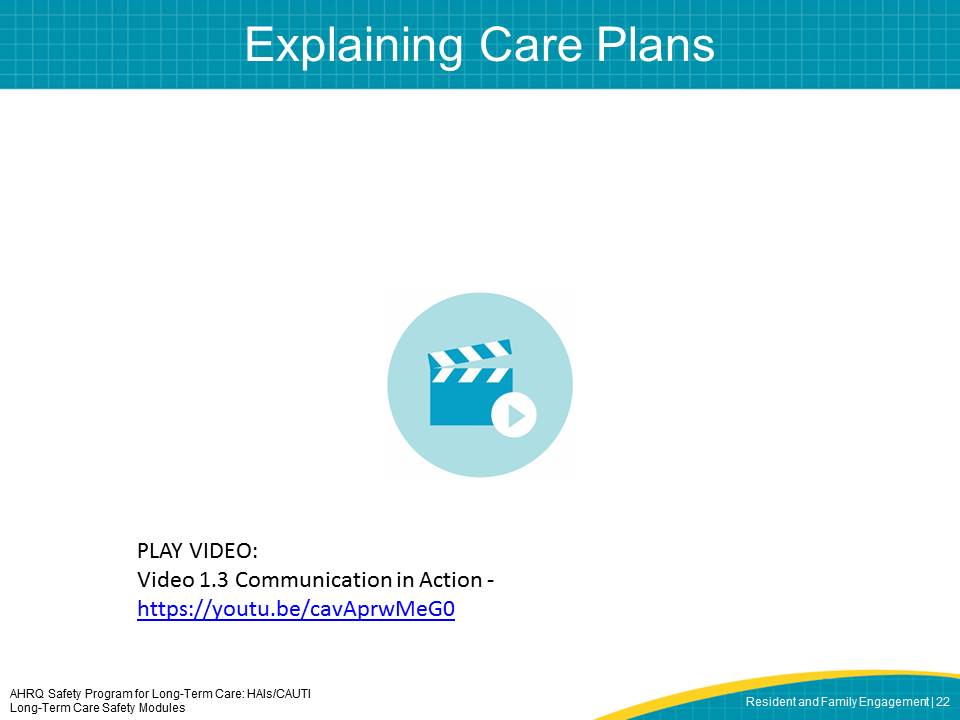
Say:
In the following video, a resident's daughter, CNA, nurse and nurse manager have a conversation about the care plan and next steps. Watch this demonstration of how staff engage family in explaining care plans.
PLAY VIDEO:
Video 1.3 Communication in Action
Ask:
What elements of good communication can you identify from the video?
How did the nurse manager address the family member's concerns?
What are things that you can do to improve communication concerning the plan of care?
Slide 23: Explaining How We Are Changing To Improve Care6
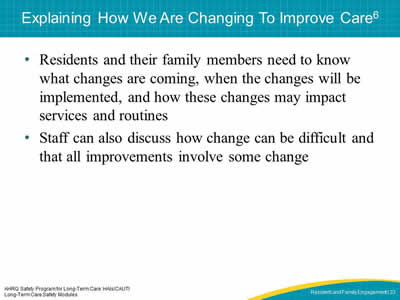
Say:
In addition to communicating about care plans, residents and family members should be aware of any changes that may be implemented in the facility, such as changes to policies, schedules or the implementation of safety programs that might affect the care a resident is receiving. Residents and family members should receive information concerning why these changes are being made and how these changes can impact staff, the resident and the family. It is also important to share that change can be difficult and that all improvements involve some change.
6. Turnham H. Resident and Family Centered Care. AHRQ Safety Program for Long-Term Care: CAUTI, July Content Webinar; July 2014.
Slide 24: Questions That You Answer6
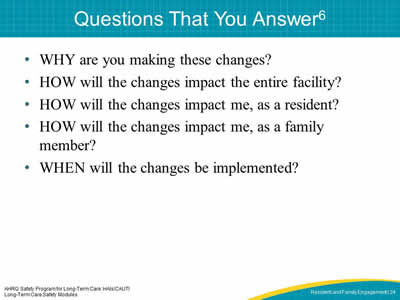
Say:
The following are questions you and all facility staff should be prepared to answer about any changes that may be implemented in the facility.
Ask:
How would you answer these questions?
6. Turnham H. Resident and Family Centered Care. AHRQ Safety Program for Long-Term Care: CAUTI, July Content Webinar; July 2014.
Slide 25: Communication Tools6
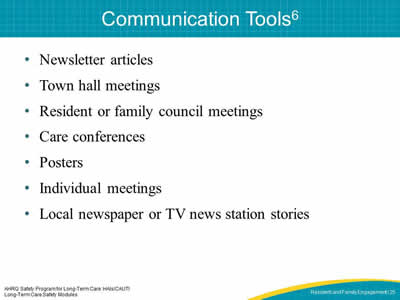
Say:
There are many ways to communicate information, including changes, to residents and family members. Some of the most common tools are newsletter articles, posters, town hall meetings, resident or family council meetings, care conferences, posters, individual meetings, and local newspaper or TV news stories.
Ask:
What are the ways you communicate information now in your facility? What are some other ways you can communicate information or changes?
6. Turnham H. Resident and Family Centered Care. AHRQ Safety Program for Long-Term Care: CAUTI, July Content Webinar; July 2014.
Slide 26: New Ideas for Communicating6
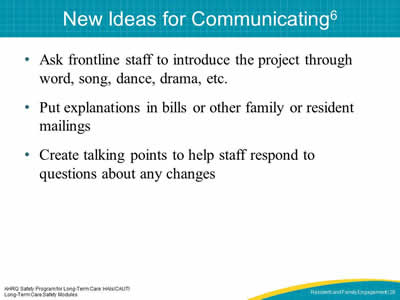
Say:
There are a number of other ways that facilities can communicate important information, including—
- Ask frontline staff to introduce the project through word, song, dance, drama, et cetera.
- Put explanations in bills or other family or resident mail.
- Ask your governing board to do a presentation.
- Use graphics and charts to provide support for visual learners.
- Create talking points so all staff can answer simple questions about the project.
Ask:
How does your facility currently communicate changes with residents and family members?
Can you think of any other ways to relay information?
6. Turnham H. Resident and Family Centered Care. AHRQ Safety Program for Long-Term Care: CAUTI, July Content Webinar; July 2014.
Slide 27: Resident and Family Engagement Checklist
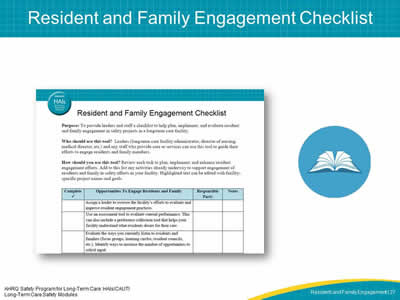
Say:
Leaders and staff may find it helpful to use a list of resident and family engagement practices to guide their efforts. This checklist was designed to provide leaders and staff a simple tool to help plan, implement and evaluate resident and family engagement in safety projects. The tool can be used by leaders (LTC facility administrator, Director of Nursing, Medical Director, etc.) and any staff who provide care or services. To use the checklist, first review each task and decide which activities may already be underway in your facility. Then, add additional activities or expand existing efforts to enhance engagement of residents and family in your facility.
Slide 28: Challenges to Communication
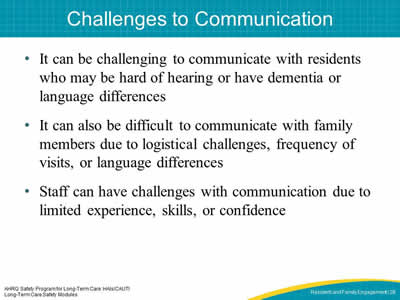
Say:
Communication and engagement with residents and family members can be challenging for a number of reasons, including language differences, health literacy levels, or health complications like dementia or loss of hearing. It is important to recognize these challenges and implement methods to address each challenge.
Ask:
What challenges have you seen in your facility? How does your facility address each of these challenges?
Slide 29: How To Address Communication Challenges
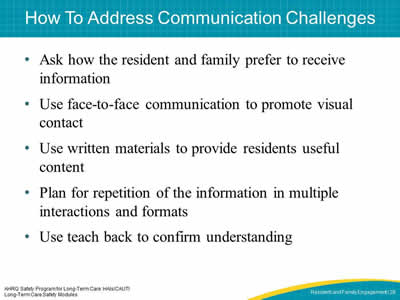
Say:
A few methods you can use to address communication challenges include—
- Ask how the resident and family prefer to receive information. If the resident is hard of hearing, does the resident have hearing aids that work and does the resident use their hearing aids?
- Use face-to-face communication to promote visual contact.
- Use written materials that provide useful and relevant content based on the resident's needs and preferences.
- Plan to repeat information using multiple interactions and formats as needed.
- Use teach-back methods to confirm understanding.
Additional strategies and tools for communicating with residents and family are located in the Teamwork and Communication module.
Slide 30: Engagement Using Resident and Family Advisers7
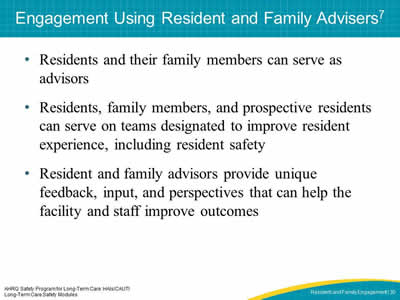
Say:
Some facilities have engaged residents and family members by designating residents as advisers. An adviser can be a current or past resident or family member who has agreed to provide their input and perspectives to help improve processes and care at your facility. A resident and family adviser offers a unique perspective on the care provided at the facility and can be a valuable team member on safety and quality committees.
7. Patient and Family Engagement module, CUSP Toolkit. Rockville, MD: Agency for Healthcare Research and Quality; December 2012. Accessed September 22, 2014.
Slide 31: Resident and Family Advisers in Nursing Homes7
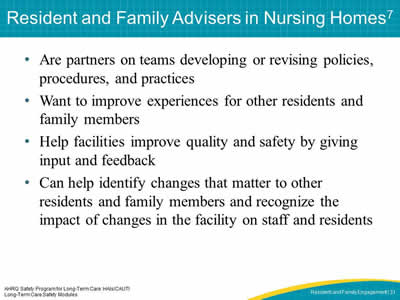
It is important to recognize that a resident and family adviser is a partner and team member when developing facility policies, procedures, and practices. Some facilities may use a formal process, such as an application and interview process, to invite resident and family advisers to serve on committees. Remember, effective advisers want to improve experiences for other residents and family members and help facilities improve quality and safety by giving meaningful input and feedback. Residents and their family members are ready to become advisers when they are—
- willing to talk about their experiences constructively,
- ready to work with people from different backgrounds who have different viewpoints, and
- willing to be discreet about the information they receive.
Residents and family members who are interested in becoming advisers can refer to the Am I Ready to Become an Adviser tool, which is included at the end of this module. Once a committee chooses a resident and family adviser, the committee leaders should work to create a safe, considerate environment for the resident and family adviser to share his or her experiences and opinions. It is helpful to prepare health care professionals who will be working with advisers by explaining the adviser's role, contributions, and expectations for involvement. The committee leader may also need to help the resident and family adviser learn ways to express the concerns of residents and families while being respectful of the health care staff. Facilities interested in identifying resident and family advisers should consider asking advisers who represent different cultures and those who do not speak English to assure a variety of perspectives are secured. If the facility chooses a non-English-speaking adviser, the facility should access a medical interpreter to support the needs of the adviser in meetings.
Advisers can also help facilities identify changes that matter to other residents and family members and recognize the impact of changes in the facility on staff and residents. Advisers can effectively collaborate with staff to develop resident- and family-centered policies and procedures. Staff members should consider the opinions of advisers and consult with advisers prior to making decisions about resident experiences, care delivery, educational materials, and facility design.
7. Patient and Family Engagement module, CUSP Toolkit. Rockville, MD: Agency for Healthcare Research and Quality; December 2012. Accessed September 22, 2014.
Slide 32: Characteristics of an Engaged Adviser7
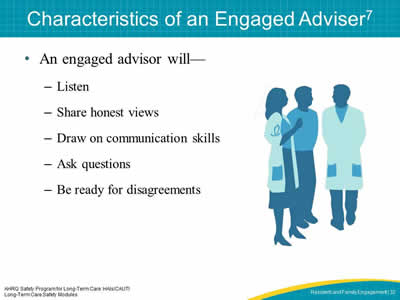
Say:
There are a number of desirable characteristics for a resident and family adviser. Below is a brief description of each of these characteristics. When selecting advisers, think about these and other characteristics that can help assure success for resident and family advisers in your facility.
Listen well
Effective advisers are good listeners. They listen to the questions staff ask and provide respectful, honest feedback. Advisers work with physicians, nurses, administrators, and support staff to ensure their contributions are received. Staff may use active listening and repeat back to validate that the information the adviser is trying to convey is understood.
Share views
Resident and family advisers are open to sharing their experiences with facility staff. They provide constructive feedback, and focus on how to prevent a problem from reoccurring rather than just focusing on what happened. Effective advisers are balanced in their positive and constructive input.
Communicate effectively
Effective communication ensures the best outcomes from meetings with the facility staff and adviser. Making sure everyone understands the ideas being discussed will contribute to successful meetings.
Ask questions
Resident and family advisers need to feel comfortable asking nurses, physicians, and administrators questions, and the care team should feel comfortable asking the adviser questions.
Expect disagreements
Advisers and facility staff should be prepared to resolve disagreements respectfully and not take others' opinions personally.
7. Patient and Family Engagement module, CUSP Toolkit. Rockville, MD: Agency for Healthcare Research and Quality; December 2012. Accessed September 22, 2014.
Slide 33: How To Work With Resident and Family Advisers7
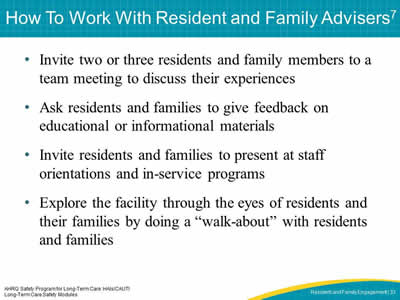
Say:
Facility safety teams can involve resident and family advisers in their work by—
- Inviting two or three residents and family members to a team meeting to discuss their facility experience.
- Asking residents and families to give feedback on educational or informational materials.
- Inviting residents and families to present at staff orientations and in-service programs.
- Exploring the facility through the eyes of residents and their families by doing a "walkabout" with residents and families.
These informal thought-sharing activities will help facility staff gain a better understanding of the needs and attitudes of residents and their families.
Resident and family advisers can offer insights that are different from the facility staff's. They help the team develop new priorities and innovative ideas that contribute to delivering high-quality, resident-centered care.
Ask:
Are residents and family members currently serving as advisers in your facility? If not, is there an opportunity for your facility to identify and engage resident advisers?
7. Patient and Family Engagement module, CUSP Toolkit. Rockville, MD: Agency for Healthcare Research and Quality; December 2012. Accessed September 22, 2014.
Slide 34: How To Work with Resident and Family Advisers
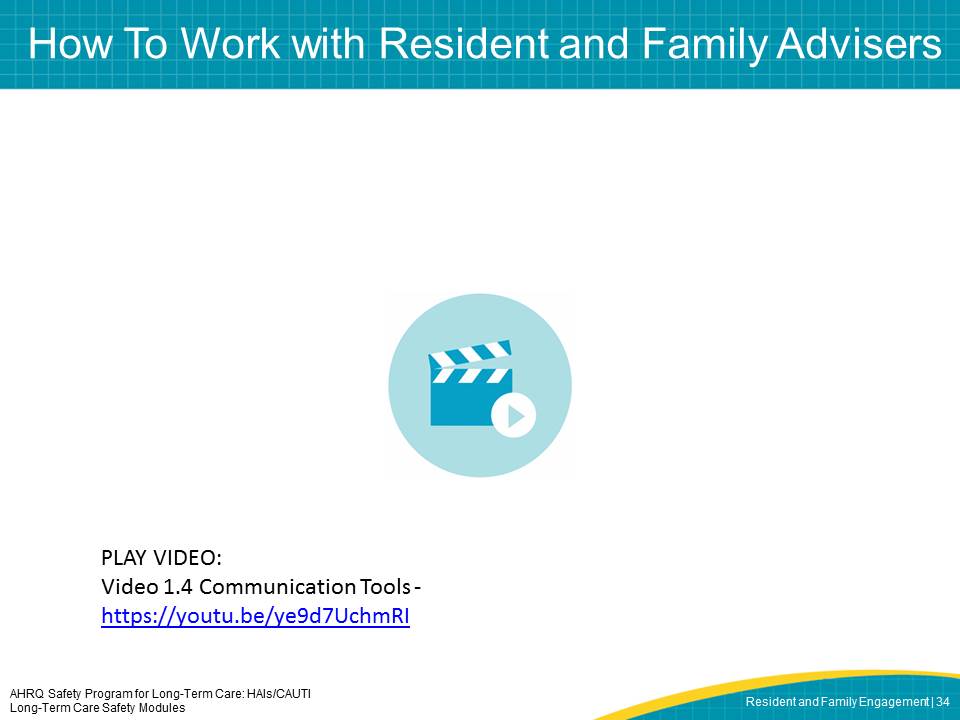
Say:
Watch the video to see how this facility learned from an interaction with a family member who had a concern. We can learn a lot from the experiences of resident and family advisers.
PLAY VIDEO:
Video 1.4 Communication Tools
Ask:
What important concepts did the CNA, nurse and nurse manager take away from their conversation with the family member? How might you work with resident and family advisers?
Slide 35: Long-Term Care Ombudsman Program8
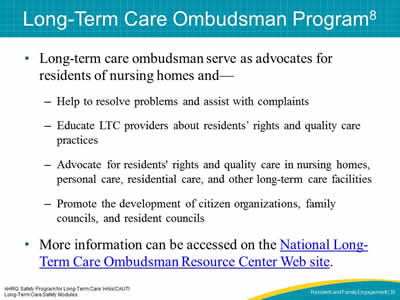
Say:
There is also a national program that supports the role of long-term care ombudsman (LTCO). The LTCO serves as an advocate for residents of nursing homes, board and care homes, and assisted living facilities. The Ombudsman Program was created in 1972 as a Public Health Service demonstration project to meet the needs of residents facing problems in nursing homes. There are long-term care ombudsman programs for each state, as well as networks of regional or local programs. More information can be found on the National Long-Term Care Ombudsman Resource Center Web site.
Ombudsmen provide information about how to find a facility and what to do to get quality care when residing in a long-term care facility. The LTCO are trained to resolve problems and to help residents and families resolve specific complaints. The resident and family members must give the ombudsman permission to share their concerns, otherwise, resident and family complaints are kept confidential. Under the Federal Older Americans Act, every State is required to have an Ombudsman Program that addresses resident complaints and advocates for improvements in the long-term care system.
In summary, a Long-Term Care Ombudsman—
- Resolves complaints made by or on behalf of residents of long-term care facilities.
- Educates consumers and long-term care providers about residents' rights and good care practices.
- Promotes community involvement through volunteer opportunities.
- Provides information to the public on long-term care facilities and services, and legislative and policy issues.
- Advocates for residents' rights and quality care in nursing homes, personal care, residential care, and other long-term care facilities.
- Promotes the development of citizen organizations, family councils, and resident councils.
8. National Long-Term Care Ombudsman Resource Center. About Ombudsmen. Washington, D.C.: National Long-Term Care Ombudsmen Resource Center. Accessed September 22, 2014.
Slide 36: Key Concepts Review
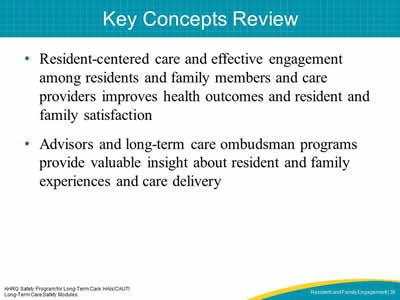
Say:
Resident-centered care and effective engagement among residents, family members, and care providers improves health outcomes and resident and family satisfaction. Organizations should be prepared to partner with residents and family members to improve care and ensure clear and open communication among all team members. Advisers and long-term care ombudsmen programs can provide valuable insight and perspectives to support resident safety and exceptional experiences for residents and family members.
Slide 37: Tools
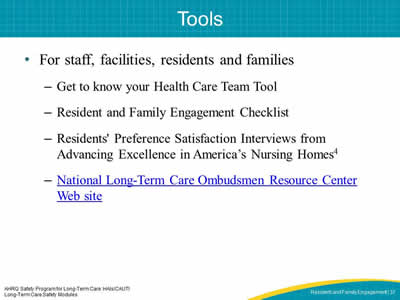
- For staff, facilities, residents and families
- Get to know your Health Care Team Tool.
- Resident and Family Engagement Checklist.
- Residents' Preference Satisfaction Interviews from Advancing Excellence in America's Nursing Homes4
- National Long-Term Care Ombudsmen Resource Center Web site.
Slide 38: References
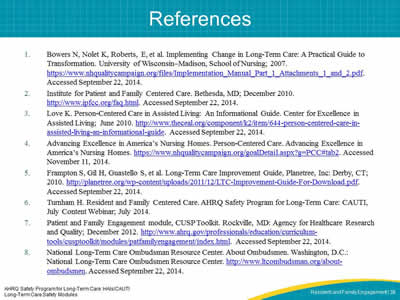
- Bowers N, Nolet K, Roberts, E, et al. Implementing Change in Long-Term Care: A Practical Guide to Transformation. University of Wisconsin–Madison, School of Nursing; 2007. Accessed September 22, 2014.
- Institute for Patient and Family Centered Care. Bethesda, MD; December 2010. Accessed September 22, 2014.
- Love K. Person-Centered Care in Assisted Living: An Informational Guide. Center for Excellence in Assisted Living; June 2010. Accessed September 22, 2014.
- Advancing Excellence in America's Nursing Homes. Person-Centered Care. Advancing Excellence in America's Nursing Homes. Accessed November 11, 2014.
- Frampton S, Gil H, Guastello S, et al. Long-Term Care Improvement Guide, Planetree, Inc: Derby, CT; 2010. Accessed September 22, 2014.
- Turnham H. Resident and Family Centered Care. AHRQ Safety Program for Long-Term Care: CAUTI, July Content Webinar; July 2014.
- Patient and Family Engagement module, CUSP Toolkit. Rockville, MD: Agency for Healthcare Research and Quality; December 2012. Accessed September 22, 2014.
- National Long-Term Care Ombudsman Resource Center. About Ombudsmen. Washington, D.C.: National Long-Term Care Ombudsmen Resource Center. Accessed September 22, 2014.



